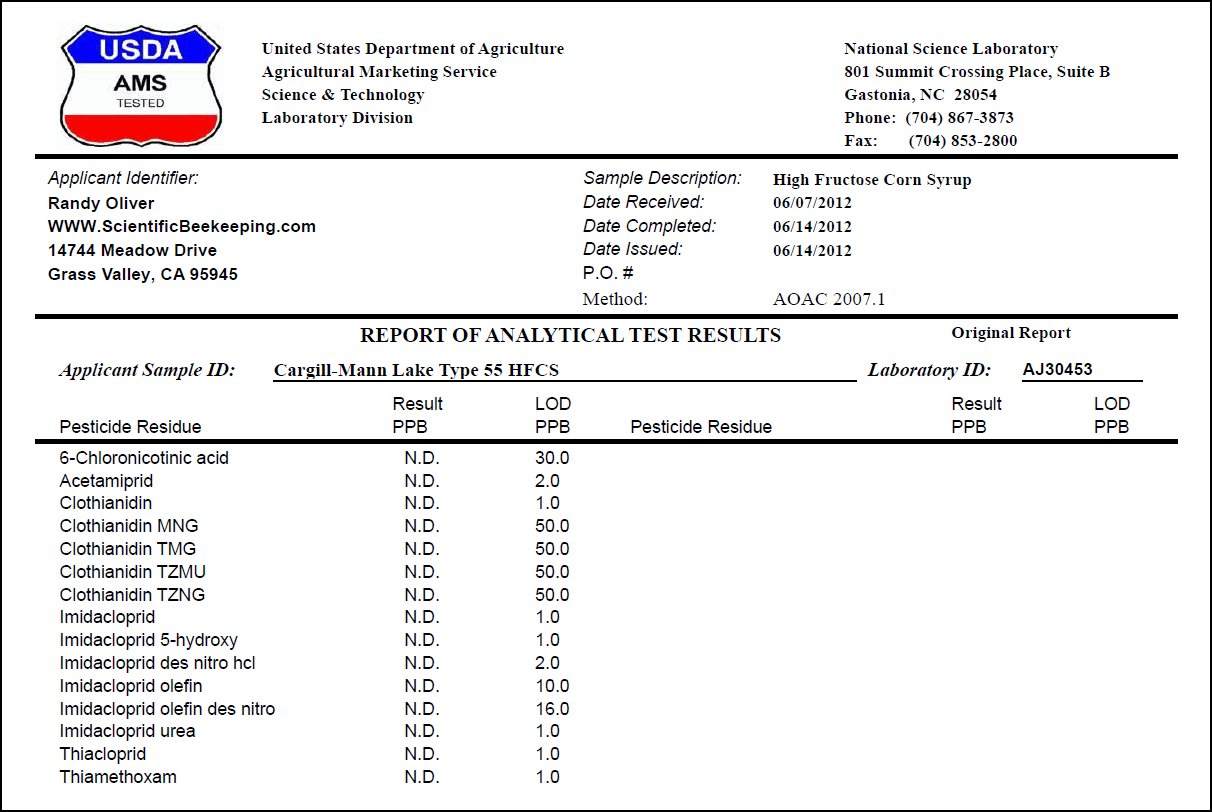Testing of Bee Feed Syrups for Neonicotinoid Residues
Testing of Bee Feed Syrups for Neonicotinoid Residues
Eric Mussen1 and Randy Oliver2
First Published in ABJ in August 2012
The widespread adoption of the systemic neonicotinoid insecticides has led a number of beekeepers to question whether the commercially available corn, beet, or cane sugar syrups might be contaminated with residues of those insecticides.
Introduction
Beekeepers often feed some form of sugar syrup to colonies for either buildup or winter stores. The raw materials for sugar production come mainly from three cultivated crops–traditionally sugar cane or sugar beets, from which sucrose is extracted; or from corn (maize), from which high fructose corn syrup (HFCS) is produced.
In recent years, growers have widely adopted the practice of treating corn and sugar beet seed with systemic neonicotinoid insecticides [1, 2, 3], and clothianidin may be used on sugar cane in some areas [4]. The understanding that these insecticides are “systemic” (transported throughout the plant tissues) has led some beekeepers to question whether residues may make it into the final sugar product.
We submitted samples of the bee feed syrups offered by two major U.S. suppliers for independent testing. Residues of neonicotinoid insecticides, as well as their degradation products, can be multiply-detected at as little as ppb levels by modern analytical instrumentation [5].
Materials and Methods
We solicited samples of syrups (Table 1) from Stuart Volby of Mann Lake Ltd. (Mann Lake, MN) and from Dadant (Chico, CA) branch manager John Gomez, which we reshipped for testing to Roger Simonds, Laboratory Manager of the USDA Agricultural Marketing Service lab. We requested analyses for neonicotinoid insecticides and their principal degradates.
| Supplier | Manufacturer | Syrup Type |
| Mann Lake Ltd. | Cargill | Type 55 HFCS
Type 42 HFCS Liquid sucrose (beet) Liquid sucrose (cane) |
| Dadant & Sons, Inc. (Chico branch) | Archer Daniels Midland (ADM) | California blend:
50% Type 42 HFCS 50% Liquid sucrose (cane) |
Table 1. Bee feed syrups submitted for analysis.
1 Extension Apiculturist, University of California, Davis, CA 95616
2 Proprietor, Golden West Apiaries, Grass Valley, CA 95945
Results
None of the tested samples contained detectable levels of either the neonicotinoid parent compounds or their degradates (Fig. 1).
Figure 1. Typical test results. The LOD is the “limit of detection,” i.e., the lowest concentration in parts per billion (ppb) that the instrument can detect. The lab tested for both parent compounds (e.g., imidacloprid) as well as for the degradation products of the insecticides, which may also exhibit toxicity.
Discussion
Although no residues were detected in the syrup samples submitted for testing, the possibility exists that there were residues below the limit of detection (1 ppb for most of the parent compounds). However, levels below 1 ppb are generally accepted as being well below the no observable adverse effects concentration (NOAEC) [6].
These results are not surprising for HFCS, given that when the USDA tested 655 samples of corn grain in 2007 [7], no residues of neonicotinoid insecticides were detected. Although the tolerance level for clothianidin in sugar beets is 20 ppb [8], there are often no detectable residues from beets in the field [9]. Similarly, there were no detectable residues in the sample of beet sugar that we submitted.
Although this was a very limited sampling, it gave no evidence that beekeepers need to be concerned about neonicotinoid insecticide residues in feed syrups from the major suppliers.
Acknowledgements
Thanks to the cooperation of Stuart Volby and John Gomez for supplying samples, Roger Simonds for expediting the analyses, and to the U.C. Davis Extension Apiculture Program for providing funds for sample analyses.
References
[1] Anon (2012) 2012 Corn Insect Control Recommendations. http://eppserver.ag.utk.edu/redbook/pdf/corninsects.pdf
[2] Valent (2011) Valent USA Announces NipsIt™ SUITE Sugar Beet Seed Treatment System. http://www.seedtoday.com/info/ST_articles.html?ID=113940
[3] Syngenta (2012) CRUISER FORCE sugar beet seed – the UK’s number one choice. http://www.syngenta-crop.co.uk/pdfs/products/CruiserSB_uk_technical_update.pdf#view=fit
[4] APVMA (2010) Trade Advice Notice on clothianidin in the product Sumitomo Shield systemic insecticide http://www.apvma.gov.au/registration/assessment/docs/tan_clothianidin_60689.pdf
[5] http://quechers.cvua-stuttgart.de/
[6] Decourtye, A (2003) Learning performances of honeybees (Apis mellifera L) are differentially affected by imidacloprid according to the season. Pest Manag Sci 59: 269-278.
[7] USDA (2008) Pesticide Data Program Annual Summary, Calendar Year 2007, Appendix F Distribution of Residues by Pesticide in Corn Grain http://www.ams.usda.gov/AMSv1.0/getfile?dDocName=STELPRDC5074338
[8] Federal Register (2008) Clothianidin; Pesticide Tolerance. https://www.federalregister.gov/articles/2008/02/06/E8-1784/clothianidin-pesticide-tolerance
[9] FAO (2005) Clothianidin, Table 103. http://www.fao.org/fileadmin/templates/agphome/documents/Pests_Pesticides/JMPR/Evaluation10/Chlotiahinidin.pdf




